Chapter 4 - Absorption by Roots Exercise 48
Question 1
Define the following:
(i) Osmosis
(ii) Diffusion
(iii) Turgor pressure
(iv) Hypertonic solution
(v) Plasmolysis
(i) Osmosis
(ii) Diffusion
(iii) Turgor pressure
(iv) Hypertonic solution
(v) Plasmolysis
Solution 1
(i) Osmosis - Osmosis is the movement of solvent molecules from a region of higher concentration to a region of lower concentration through a semi-permeable membrane.
(ii) Diffusion - It is the movement of molecules or ions from a region of higher concentration to a region of lower concentration to equalize the concentration of the two regions.
(iii) Turgor Pressure - It is the actual hydrostatic pressure developed inside a cell as a result of entry of water into it.
(iv) Hypertonic solution - A solution whose concentration is more than that of cell sap is called hypertonic solution.
(v) Plasmolysis - The shrinkage of cytoplasm of a living cell as a result of exosmosis is known as plasmolysis.
(ii) Diffusion - It is the movement of molecules or ions from a region of higher concentration to a region of lower concentration to equalize the concentration of the two regions.
(iii) Turgor Pressure - It is the actual hydrostatic pressure developed inside a cell as a result of entry of water into it.
(iv) Hypertonic solution - A solution whose concentration is more than that of cell sap is called hypertonic solution.
(v) Plasmolysis - The shrinkage of cytoplasm of a living cell as a result of exosmosis is known as plasmolysis.
Question 2
Give an account of the importance of turgor pressure in a herbaceous plant.
Solution 2
Turgor pressure keeps the soft organs like flowers, young shoots, leaves, etc. in stretched form. It is also essential for the growth of the cells. Changes in the turgor pressure causes opening and closing of stomata.
Question 3
Mention two ways in which root hairs are suited for absorption of water from the soil?
Solution 3
(i) The epidermis and endodermis of root hairs are permeable to water.
(ii) Root hairs have a very large surface area.
(ii) Root hairs have a very large surface area.
Question 4
(i) How is root hair adapted for the absorption of water from the soil?
(ii) What part is played by
(a) the cell wall?
(b) The cytoplasm in the uptake of water into the root hair?
(iii) What would happen to the root hair of a potted plant if the soil was watered with an extremely concentrated solution of sodium chloride?
(ii) What part is played by
(a) the cell wall?
(b) The cytoplasm in the uptake of water into the root hair?
(iii) What would happen to the root hair of a potted plant if the soil was watered with an extremely concentrated solution of sodium chloride?
Solution 4
(i) The main root with its many branches form a network in the soil. The root hairs get entangled in the soil particles and remain in close contact with the capillary water surrounding the soil particles. The epidermal cells of root hairs have vacuoles which contain cell sap. Generally, the cell sap is more concentrated than the soil solution. As a result the water enters inside the root hair cells by endosmosis. This water dilutes the epidermal cell sap solution. Then water enters into the cortical cells by osmosis and reaches the endodermal cells and then pericycle cells. From this layer water then enters in the xylem tissue. In this way, the water is absorbed and translocated up to xylem of the root by osmosis.

(ii) (a) Cell wall separates the two solutions - cell sap and soil solution and is permeable which means it allows the water to enter inside the root hair cells by endosmosis.
(b) The cytoplasm contains vacuoles having cell sap or solution of mineral salts. This cell sap being more concentrated than the soil solution help in water absorption by endosmosis.
(iii) If the soil was watered with extremely concentrated solution of sodium chloride, the water will move out from the root hair due to osmosis and thus, plasmolysis will take place.

(ii) (a) Cell wall separates the two solutions - cell sap and soil solution and is permeable which means it allows the water to enter inside the root hair cells by endosmosis.
(b) The cytoplasm contains vacuoles having cell sap or solution of mineral salts. This cell sap being more concentrated than the soil solution help in water absorption by endosmosis.
(iii) If the soil was watered with extremely concentrated solution of sodium chloride, the water will move out from the root hair due to osmosis and thus, plasmolysis will take place.
Question 5
What is the difference between diffusion and osmosis?
Solution 5

Question 6
What is the difference between endosmosis and exosmosis?
Solution 6

Question 7
Define root pressure.
Solution 7
The pressure of water developed inside the roots due to active absorption of water when transpiration is very low and the rate of absorption is high is known as root pressure.
Question 8
What is permeability?
Solution 8
Permeability is the property of a membrane to allow the passage of both solute and solvent molecules.
Question 9
Which part of the root absorbs maximum water and why?
Solution 9
Root hairs absorb maximum water because in this region, the xylem is not fully mature but the epidermis and endodermis are still permeable to water.
Question 10
What are the functions of root?
Solution 10
(i) Roots help in the absorption of water.
(ii) They also help in the absorption of minerals.
(ii) They also help in the absorption of minerals.
Question 11
Distinguish between the following:
(i) Filtration and diffusion
(ii) Turgor pressure and osmotic pressure
(iii) Hypotonic and hypertonic solutions
(iv) Osmosis and diffusion
(v) Flaccid condition and turgid condition
(vi) Plasmolysis and deplasmolysis
(i) Filtration and diffusion
(ii) Turgor pressure and osmotic pressure
(iii) Hypotonic and hypertonic solutions
(iv) Osmosis and diffusion
(v) Flaccid condition and turgid condition
(vi) Plasmolysis and deplasmolysis
Solution 11
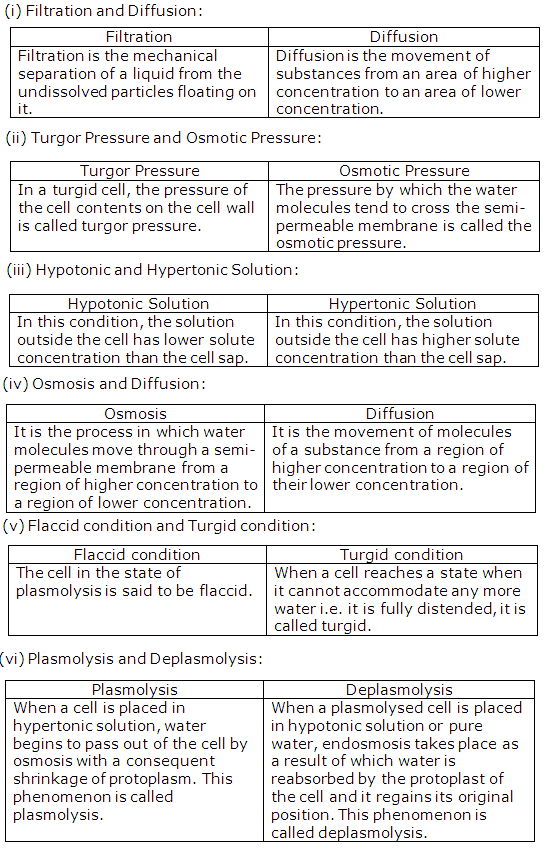
Question 12
What is the utility of plasmolysis?
Solution 12
Plasmolysis helps in the preservation of meat and fish by salting. It is also helpful in the preservation of jellies and jams by adding concentrated sugar solution to them. It helps in plasmolysing the spores of bacteria and fungi.
Chapter 4 - Absorption by Roots Exercise 49
Question 1
The apparatus arranged alongside signifies an important process.
(i) Name the process.
(ii) Where does this process occur in plants?
(iii) What solution is placed inside the dialysis tubing?
(iv) What happens to the level of the solution in the capillary tube?
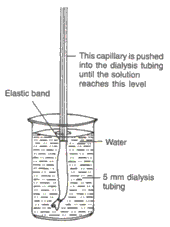
(i) Name the process.
(ii) Where does this process occur in plants?
(iii) What solution is placed inside the dialysis tubing?
(iv) What happens to the level of the solution in the capillary tube?

Solution 1
(i) Osmosis
(ii) Root hair
(iii) Sugar solution
(iv) The level of the liquid in the capillary tube rises.
(ii) Root hair
(iii) Sugar solution
(iv) The level of the liquid in the capillary tube rises.
Question 2
Name the following:
(i) The pressure with which the molecules of a substance diffuse.
(ii) Two solutions having same concentrations.
(iii) The force developing in shoot responsible for most of the absorption of water.
(iv) The uptake of mineral ions against concentration gradient.
(v) Tissue concerned with upward conduction of water.
(vi) Condition of cell in which the cell contents are shrunken.
(vii) The inward movement of solvent molecules through the plasma membrane of cell.
(viii) The process by which raisins swell up when placed in a beaker of water.
(ix) Movement of molecules from a region of high concentration to a region of low concentration.
(i) The pressure with which the molecules of a substance diffuse.
(ii) Two solutions having same concentrations.
(iii) The force developing in shoot responsible for most of the absorption of water.
(iv) The uptake of mineral ions against concentration gradient.
(v) Tissue concerned with upward conduction of water.
(vi) Condition of cell in which the cell contents are shrunken.
(vii) The inward movement of solvent molecules through the plasma membrane of cell.
(viii) The process by which raisins swell up when placed in a beaker of water.
(ix) Movement of molecules from a region of high concentration to a region of low concentration.
Solution 2
(i) Osmotic pressure
(ii) Isotonic solutions
(iii) Cohesive force
(iv) Active absorption
(v) Xylem
(vi) Plasmolysis
(vii) Endosmosis
(viii) Endosmosis
(ix) Diffusion
(ii) Isotonic solutions
(iii) Cohesive force
(iv) Active absorption
(v) Xylem
(vi) Plasmolysis
(vii) Endosmosis
(viii) Endosmosis
(ix) Diffusion
Question 3
Name the tissue concerned with upward conduction of water in plants.
Solution 3
Xylem
Question 4
Name the condition in which the cell contents are shrunken.
Solution 4
Plasmolysis
Question 5
Explain briefly whydo not root hairs become flaccid when fertilisers are added to the moist soil around them?
Solution 5
The root hairs become flaccid when fertilisers are added to the moist soil around them because fertilisers with moist soil become hypertonic which causes plasmolysis in the cells of the root hair. The turgidity is lost and the cell becomes flaccid.
Question 6
Name the process by which molecules distribute themselves evenly within the space they occupy ______ (Fill in the blank).
Solution 6
Diffusion
Question 7
Name the term for the inward movement of solvent molecules through the plasma membrane of a cell.
Solution 7
Endosmosis
Question 8
The diagram given below represents a plant cell after being placed in a strong sugar solution. Guidelines 1 to 5 indicate the following:
1. Strong sugar solution
2. Cell wall
3. Protoplasm
4. Large vacuole
5. Nucleus
Study the diagram and answer the questions that follow:
(i) What is the state of the cell shown in the diagram?
(ii) Name the structure which acts as a selectively permeable membrane.
(iii) If the cell had been placed in distilled water instead of strong sugar solution which feature would not have been present?
(iv) If the cell in the diagram possessed chloroplasts where would these be present?
(v) Name any one feature of this plant cell which is not present in animal cells.
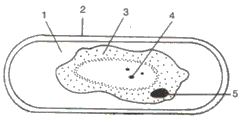
1. Strong sugar solution
2. Cell wall
3. Protoplasm
4. Large vacuole
5. Nucleus
Study the diagram and answer the questions that follow:
(i) What is the state of the cell shown in the diagram?
(ii) Name the structure which acts as a selectively permeable membrane.
(iii) If the cell had been placed in distilled water instead of strong sugar solution which feature would not have been present?
(iv) If the cell in the diagram possessed chloroplasts where would these be present?
(v) Name any one feature of this plant cell which is not present in animal cells.

Solution 8
(i) Plasmolysed cell
(ii) Plasma membrane
(iii) Large vacoule
(iv) The chloroplasts would be present in the shrunken protoplast.
(vi) Cell wall
(ii) Plasma membrane
(iii) Large vacoule
(iv) The chloroplasts would be present in the shrunken protoplast.
(vi) Cell wall
Chapter - Exercise
Solution 1
Chapter 4 - Absorption by Roots Exercise 50
Question 1
Explain why:
(i) Raisins swell up in water.
(ii) We gargle with saline solution in case of throat infection.
(iii) Bacteria and fungi do not grow in pickles, jams, jellies and squashes.
(iv) The leaves of wilted lettuce, if kept in cold water, become crisp.
(i) Raisins swell up in water.
(ii) We gargle with saline solution in case of throat infection.
(iii) Bacteria and fungi do not grow in pickles, jams, jellies and squashes.
(iv) The leaves of wilted lettuce, if kept in cold water, become crisp.
Solution 1
(i) The raisins swell up when placed in water because the water is hypotonic as compared to the raisins so the water enters inside the raisins as a result of endosmosis.
(ii) Saline water is hypertonic. So any infectious agent such as bacteria in the throat gets plasmolysed and this cures the infection.
(iii) Jam, jellies and pickles are kept in hypertonic solution of sugar or salt in which plasmolysis of bacteria and fungi takes place. This kills the bacteria and fungi and hence, pickles, jam and jellies are preserved properly.
(iv) The leaves of the wilted lettuce become crisp when kept in cold water because they take up water due to endosmosis in hypotonic solution.
(ii) Saline water is hypertonic. So any infectious agent such as bacteria in the throat gets plasmolysed and this cures the infection.
(iii) Jam, jellies and pickles are kept in hypertonic solution of sugar or salt in which plasmolysis of bacteria and fungi takes place. This kills the bacteria and fungi and hence, pickles, jam and jellies are preserved properly.
(iv) The leaves of the wilted lettuce become crisp when kept in cold water because they take up water due to endosmosis in hypotonic solution.
Question 2
Define ascent of sap.
Solution 2
Ascent of sap is the movement of water from the roots to the upper part of the plant.
Question 3
Why do plants die when salt is sprinkled over them?
Solution 3
Plants die when salt is sprinkled over them due to plasmolysis of cells. The salt makes the solution hypertonic inside the plant cells which lead to shrinkage of cells or exosmosis.
Question 4
Define root pressure. How would you demonstrate it experimentally?
Solution 4
Root Pressure is the pressure exerted on the liquid contents of the cortical cells of the root, under fully turgid condition, forcing a quantity of water into the xylem vessels and through them upwards into the stem up to a certain height.
Demonstration of Root pressure:
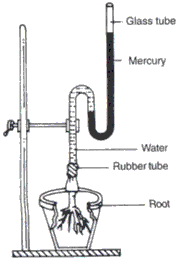
(a) Take a well matured healthy herbaceous plant.
(b) The stem of the plant is cut a few centimeters above the base with a sharp knife and attached to a manometer through a rubber tube.
(c) After a few hours, the level of mercury rises in the manometer.
(d) This is due to the pressure created by water exuded from the cut end of the plant on account of root pressure generated due to entry of water in the root cells.
Demonstration of Root pressure:

(a) Take a well matured healthy herbaceous plant.
(b) The stem of the plant is cut a few centimeters above the base with a sharp knife and attached to a manometer through a rubber tube.
(c) After a few hours, the level of mercury rises in the manometer.
(d) This is due to the pressure created by water exuded from the cut end of the plant on account of root pressure generated due to entry of water in the root cells.
Question 5
Give at least three uses of water to green plants.
Solution 5
(i) Water is one of the raw materials for photosynthesis.
(ii) Water is important for seed germination.
(iii) Water controls the opening and closing of stomata.
(ii) Water is important for seed germination.
(iii) Water controls the opening and closing of stomata.
Question 6
What will happen if a concentrated solution of a fertilizer is given to the potted plants?
Solution 6
Plants begin to die when concentrated solution of a fertilizer is given to potted plants because fertilizer along with soil water act as a hypertonic solution resulting in exosmosis.
Question 7
The figure shows a diagrammatic representation of the movement of certain substances inside the stem of a certain plant. Write five sentences on whatever you can explain about the processes or the arrangement of structures indicated in the diagram.
Note: - Each sentence must include one or more of the following four words, and each word can be used several times. Xylem, phloem, roots, leaves.

Note: - Each sentence must include one or more of the following four words, and each word can be used several times. Xylem, phloem, roots, leaves.

Solution 7
(i) Plants absorb water by their roots.
(ii) Roots supply water to the stem and leaves of the plant.
(iii) In root hairs, the xylem is not fully mature and the endodermis and epidermis are permeable to water.
(iv) Water is absorbed by the plants through xylem in all directions.
(v) The food on the other hand is transported with the help of phloem.
(ii) Roots supply water to the stem and leaves of the plant.
(iii) In root hairs, the xylem is not fully mature and the endodermis and epidermis are permeable to water.
(iv) Water is absorbed by the plants through xylem in all directions.
(v) The food on the other hand is transported with the help of phloem.
Question 8
The diagram given below represents the results of an experiment conducted on two freshly taken leafy shoots of a herbaceous plant. The lower ends of the shoots dip in ordinary water.
(i) What is the aim of the experiment?
(ii) Some parts of the stem in both the shoots have been removed. Name the conducting tissue in shoot (a) and in shoot (b) that has been removed.
(iii) What are the results of this experiment?
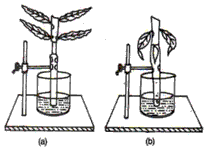
(i) What is the aim of the experiment?
(ii) Some parts of the stem in both the shoots have been removed. Name the conducting tissue in shoot (a) and in shoot (b) that has been removed.
(iii) What are the results of this experiment?

Solution 8
(i) The aim of the experiment is to show that conduction of water in plants takes place through xylem.
(ii) In shoot, (a) phloem has been removed. In shoot (b), xylem has been removed.
(iii) In shoot (b), xylem has been removed so the leaves are wilted. But in shoot (a), xylem has not been removed so the leaves are turgid.
(ii) In shoot, (a) phloem has been removed. In shoot (b), xylem has been removed.
(iii) In shoot (b), xylem has been removed so the leaves are wilted. But in shoot (a), xylem has not been removed so the leaves are turgid.
Question 9
Three plants (a), (b) and (c) were placed in beakers containing coloured water. The water in each beaker was covered with a layer of oil. The leaves were removed from plant (b), while plant (c) was exposed to strong light.
(i) In which plant, (a), (b) or (c) would the water move up the fastest?
(ii) In which plant (a), (b) or (c), would the water move up slowly?
(iii) Why was the water covered with a layer of oil?
(iv) What is being investigated by this experiment?
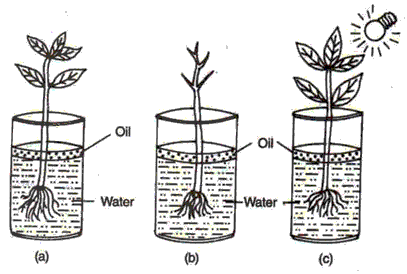
(i) In which plant, (a), (b) or (c) would the water move up the fastest?
(ii) In which plant (a), (b) or (c), would the water move up slowly?
(iii) Why was the water covered with a layer of oil?
(iv) What is being investigated by this experiment?

Solution 9
(i) In (c), the water would move up the fastest.
(ii) In (b), the water would move up slowly.
(iii) To prevent evaporation of water.
(iv) Absorption of water by the roots.
(ii) In (b), the water would move up slowly.
(iii) To prevent evaporation of water.
(iv) Absorption of water by the roots.
Chapter 4 - Absorption by Roots Exercise 51
Question 1
Choose the correct answer:
(i) Osmosis involves diffusion of
(a) suspended particles from lower concentration to higher concentration.
(b) suspended particles from higher concentration to lower concentration.
(c) water from the more concentrated solution to the less concentrated solution.
(d) water from the less concentrated solution to the more concentrated solution.
(ii) An example of a selective permeable membrane is
(a) cell wall (b) mitochondrial membrane
(c) chloroplast membrane (d) plasmalemma
(iii) Plasmolysis will occur when the cell is placed in a
(a) hypotonic solution (b) isotonic solution
(c) hypertonic solution (d) acidic solution
(iv) Grapes when placed in a strong sugar solution shrink because of
(a) diffusion (b) plasmolysis
(c) exosmosis (d) endosmosis
(v) Cell turgidity is caused by
(a) endosmosis (b) exosmosis
(c) plasmolysis (d) diffusion
(vi) If a marine plant is transferred to fresh water, it bursts due to
(a) exosmosis (b) endosmosis
(c) plasmolysis (d) diffusion
(vii) Which one is semi-permeable?
(a) Plasmalemma (b) Cell wall
(c) Endoplasmic reticulum (d) Golgi body
(viii) Swelling of wooden doors during rains is caused by
(a) endosmosis (b) imbibition
(c) capillarity (d) osmosis
(ix) Meaning of ascent of sap is
(a) absorption of water from soil.
(b) alteration of water against gravitational force.
(c) reaching of water upwards against gravitational force.
(d) origin of cohesive force in water.
(x) Process of ascent of sap in plants occurs
(a) by cortex (b) by xylem
(c) by phloem (d) by cambium
(xi) Which tissue makes passage for ascent of sap?
(a) Cortex (b) Endodermis
(c) Phloem (d) Xylem
(xii) Absorption of water from soil takes place by
(a) root cap region (b) root hairs
(c) elongation zone (d) maturation zone
(xiii) In ascent of sap water reaches upwards
(a) In the form of a solid column.
(b) in the form of a fragile column.
(c) to some places in the form of solid and to some places in liquid form.
(d) none of the above.
(xiv)The water is translocated upwards from the roots through
(a) xylem (b) phloem
(c) pith (d) endodermis
(xv) Exudation or bleeding is associated with
(a) capillarity
(b) imbibition
(c) hydrostatic pressure in the root
(d) pulsation in the innermost layer of cortex
(xvi) Wilting of plants occurs when
(a) phloem is blocked.
(b) xylem is blocked.
(c) a few old roots are removed.
(d) both xylem and phloem are blocked.
(i) Osmosis involves diffusion of
(a) suspended particles from lower concentration to higher concentration.
(b) suspended particles from higher concentration to lower concentration.
(c) water from the more concentrated solution to the less concentrated solution.
(d) water from the less concentrated solution to the more concentrated solution.
(ii) An example of a selective permeable membrane is
(a) cell wall (b) mitochondrial membrane
(c) chloroplast membrane (d) plasmalemma
(iii) Plasmolysis will occur when the cell is placed in a
(a) hypotonic solution (b) isotonic solution
(c) hypertonic solution (d) acidic solution
(iv) Grapes when placed in a strong sugar solution shrink because of
(a) diffusion (b) plasmolysis
(c) exosmosis (d) endosmosis
(v) Cell turgidity is caused by
(a) endosmosis (b) exosmosis
(c) plasmolysis (d) diffusion
(vi) If a marine plant is transferred to fresh water, it bursts due to
(a) exosmosis (b) endosmosis
(c) plasmolysis (d) diffusion
(vii) Which one is semi-permeable?
(a) Plasmalemma (b) Cell wall
(c) Endoplasmic reticulum (d) Golgi body
(viii) Swelling of wooden doors during rains is caused by
(a) endosmosis (b) imbibition
(c) capillarity (d) osmosis
(ix) Meaning of ascent of sap is
(a) absorption of water from soil.
(b) alteration of water against gravitational force.
(c) reaching of water upwards against gravitational force.
(d) origin of cohesive force in water.
(x) Process of ascent of sap in plants occurs
(a) by cortex (b) by xylem
(c) by phloem (d) by cambium
(xi) Which tissue makes passage for ascent of sap?
(a) Cortex (b) Endodermis
(c) Phloem (d) Xylem
(xii) Absorption of water from soil takes place by
(a) root cap region (b) root hairs
(c) elongation zone (d) maturation zone
(xiii) In ascent of sap water reaches upwards
(a) In the form of a solid column.
(b) in the form of a fragile column.
(c) to some places in the form of solid and to some places in liquid form.
(d) none of the above.
(xiv)The water is translocated upwards from the roots through
(a) xylem (b) phloem
(c) pith (d) endodermis
(xv) Exudation or bleeding is associated with
(a) capillarity
(b) imbibition
(c) hydrostatic pressure in the root
(d) pulsation in the innermost layer of cortex
(xvi) Wilting of plants occurs when
(a) phloem is blocked.
(b) xylem is blocked.
(c) a few old roots are removed.
(d) both xylem and phloem are blocked.
Solution 1
(i) (c) Water from the more concentrated solution to the less concentrated solution.
(ii) (d) plasmalemma
(iii) (c) hypertonic solution
(iv) (b) plasmolysis
(v) (a) endosmosis
(vi) (b) endosmosis
(vii) (a) Plasmalemma
(viii) (b) imbibition
(ix) (c) reaching of water upwards against gravitational force
(x) (b) by xylem
(xi) (d) Xylem
(xii) (b) root hairs
(xiii) (d) none of the above
(xiv) (a) xylem
(xv) (c) hydrostatic pressure in the root
(xvi) (b) xylem is blocked
(ii) (d) plasmalemma
(iii) (c) hypertonic solution
(iv) (b) plasmolysis
(v) (a) endosmosis
(vi) (b) endosmosis
(vii) (a) Plasmalemma
(viii) (b) imbibition
(ix) (c) reaching of water upwards against gravitational force
(x) (b) by xylem
(xi) (d) Xylem
(xii) (b) root hairs
(xiii) (d) none of the above
(xiv) (a) xylem
(xv) (c) hydrostatic pressure in the root
(xvi) (b) xylem is blocked

0 comments:
Post a Comment